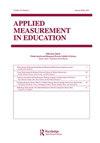Comparison of Methods for Identifying Differential Step Functioning with Polytomous Item Response Data
IF 1.1
4区 教育学
Q3 EDUCATION & EDUCATIONAL RESEARCH
引用次数: 0
Abstract
ABSTRACT Much research has been devoted to identification of differential item functioning (DIF), which occurs when the item responses for individuals from two groups differ after they are conditioned on the latent trait being measured by the scale. There has been less work examining differential step functioning (DSF), which is present for polytomous items when the conditional likelihood of responses to specific categories differ between groups. DSF impacts estimation of the measured trait and reduces the effectiveness of standard DIF detection methods. The purpose of this simulation study was to extend upon earlier work by comparing several methods for detecting the presence of DSF in polytomous items, including an approach based on the lasso estimation of the generalized partial credit model. Results show that the lasso GPCM technique controlled the Type I error rate while yielding power rates somewhat lower than logistic regression and the MIMIC model, which were not able to control the Type I error rate in some conditions. An empirical example is also presented, and implications of this study for practice are discussed.基于多同构项目响应数据的差分阶跃函数识别方法比较
差异项目功能(DIF)是指两组个体在被量表测量潜在特质后,其项目反应存在差异,目前已有大量研究致力于鉴别差异项目功能。当对特定类别的反应的条件可能性在组之间不同时,对多同构项目的差异步骤功能(DSF)的检查工作较少。DSF影响被测特征的估计,降低了标准DIF检测方法的有效性。本模拟研究的目的是在早期工作的基础上,通过比较几种检测多同义项目中DSF存在的方法,包括一种基于广义部分信用模型的套索估计的方法。结果表明,lasso GPCM技术控制了I型错误率,但产生的功率率略低于logistic回归和MIMIC模型,在某些情况下不能控制I型错误率。最后给出了一个实证例子,并讨论了本研究对实践的启示。
本文章由计算机程序翻译,如有差异,请以英文原文为准。
求助全文
约1分钟内获得全文
求助全文
来源期刊

Applied Measurement in Education
Multiple-
CiteScore
2.50
自引率
13.30%
发文量
14
期刊介绍:
Because interaction between the domains of research and application is critical to the evaluation and improvement of new educational measurement practices, Applied Measurement in Education" prime objective is to improve communication between academicians and practitioners. To help bridge the gap between theory and practice, articles in this journal describe original research studies, innovative strategies for solving educational measurement problems, and integrative reviews of current approaches to contemporary measurement issues. Peer Review Policy: All review papers in this journal have undergone editorial screening and peer review.
 求助内容:
求助内容: 应助结果提醒方式:
应助结果提醒方式:


